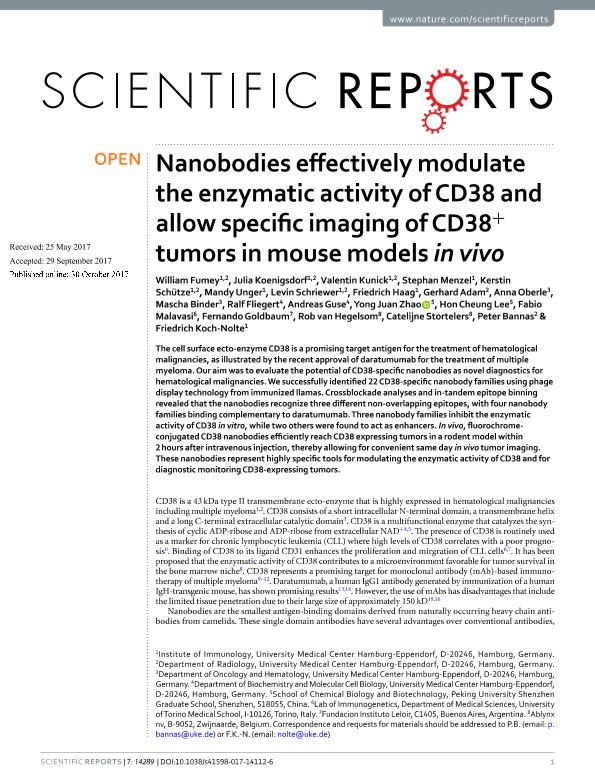Mostrar el registro sencillo del ítem
dc.contributor.author
Fumey, William
dc.contributor.author
Koenigsdorf, Julia
dc.contributor.author
Kunick, Valentin
dc.contributor.author
Menzel, Stephan
dc.contributor.author
Schütze, Kerstin
dc.contributor.author
Unger, Mandy
dc.contributor.author
Schriewer, Levin
dc.contributor.author
Haag, Friedrich
dc.contributor.author
Adam, Gerhard
dc.contributor.author
Oberle, Anna
dc.contributor.author
Binder, Mascha
dc.contributor.author
Fliegert, Ralf
dc.contributor.author
Guse, Andreas
dc.contributor.author
Zhao, Yong Juan
dc.contributor.author
Lee, Hon Cheung
dc.contributor.author
Malavasi, Fabio
dc.contributor.author
Goldbaum, Fernando Alberto

dc.contributor.author
Van Hegelsom, Rob
dc.contributor.author
Stortelers, Catelijne
dc.contributor.author
Bannas, Peter
dc.contributor.author
Koch Nolte, Friedrich
dc.date.available
2018-08-02T18:32:28Z
dc.date.issued
2017-12
dc.identifier.citation
Fumey, William; Koenigsdorf, Julia; Kunick, Valentin; Menzel, Stephan; Schütze, Kerstin; et al.; Nanobodies effectively modulate the enzymatic activity of CD38 and allow specific imaging of CD38+ tumors in mouse models in vivo; Nature Publishing Group; Scientific Reports; 7; 1; 12-2017
dc.identifier.issn
2045-2322
dc.identifier.uri
http://hdl.handle.net/11336/53932
dc.description.abstract
The cell surface ecto-enzyme CD38 is a promising target antigen for the treatment of hematological malignancies, as illustrated by the recent approval of daratumumab for the treatment of multiple myeloma. Our aim was to evaluate the potential of CD38-specific nanobodies as novel diagnostics for hematological malignancies. We successfully identified 22 CD38-specific nanobody families using phage display technology from immunized llamas. Crossblockade analyses and in-tandem epitope binning revealed that the nanobodies recognize three different non-overlapping epitopes, with four nanobody families binding complementary to daratumumab. Three nanobody families inhibit the enzymatic activity of CD38 in vitro, while two others were found to act as enhancers. In vivo, fluorochrome-conjugated CD38 nanobodies efficiently reach CD38 expressing tumors in a rodent model within 2 hours after intravenous injection, thereby allowing for convenient same day in vivo tumor imaging. These nanobodies represent highly specific tools for modulating the enzymatic activity of CD38 and for diagnostic monitoring CD38-expressing tumors.
dc.format
application/pdf
dc.language.iso
eng
dc.publisher
Nature Publishing Group
dc.rights
info:eu-repo/semantics/openAccess
dc.rights.uri
https://creativecommons.org/licenses/by-nc-sa/2.5/ar/
dc.subject
Nanobodies
dc.subject
Cd38
dc.subject
Imaging
dc.subject
Neutralizing Antibodies
dc.subject.classification
Otras Biotecnologías de la Salud

dc.subject.classification
Biotecnología de la Salud

dc.subject.classification
CIENCIAS MÉDICAS Y DE LA SALUD

dc.title
Nanobodies effectively modulate the enzymatic activity of CD38 and allow specific imaging of CD38+ tumors in mouse models in vivo
dc.type
info:eu-repo/semantics/article
dc.type
info:ar-repo/semantics/artículo
dc.type
info:eu-repo/semantics/publishedVersion
dc.date.updated
2018-07-23T18:44:51Z
dc.journal.volume
7
dc.journal.number
1
dc.journal.pais
Reino Unido

dc.journal.ciudad
Londres
dc.description.fil
Fil: Fumey, William. University Medical Center Hamburg-Eppendorf; Alemania
dc.description.fil
Fil: Koenigsdorf, Julia. University Medical Center Hamburg-Eppendorf; Alemania
dc.description.fil
Fil: Kunick, Valentin. University Medical Center Hamburg-Eppendorf; Alemania
dc.description.fil
Fil: Menzel, Stephan. University Medical Center Hamburg-Eppendorf; Alemania
dc.description.fil
Fil: Schütze, Kerstin. University Medical Center Hamburg-Eppendorf; Alemania
dc.description.fil
Fil: Unger, Mandy. University Medical Center Hamburg-Eppendorf; Alemania
dc.description.fil
Fil: Schriewer, Levin. University Medical Center Hamburg-Eppendorf; Alemania
dc.description.fil
Fil: Haag, Friedrich. University Medical Center Hamburg-Eppendorf; Alemania
dc.description.fil
Fil: Adam, Gerhard. University Medical Center Hamburg-Eppendorf; Alemania
dc.description.fil
Fil: Oberle, Anna. University Medical Center Hamburg-Eppendorf; Alemania
dc.description.fil
Fil: Binder, Mascha. University Medical Center Hamburg-Eppendorf; Alemania
dc.description.fil
Fil: Fliegert, Ralf. University Medical Center Hamburg-Eppendorf; Alemania
dc.description.fil
Fil: Guse, Andreas. University Medical Center Hamburg-Eppendorf; Alemania
dc.description.fil
Fil: Zhao, Yong Juan. Peking University; China
dc.description.fil
Fil: Lee, Hon Cheung. Peking University; China
dc.description.fil
Fil: Malavasi, Fabio. Università di Torino; Italia
dc.description.fil
Fil: Goldbaum, Fernando Alberto. Consejo Nacional de Investigaciones Científicas y Técnicas; Argentina. Fundación Instituto Leloir; Argentina
dc.description.fil
Fil: Van Hegelsom, Rob. Ablynx nv; Bélgica
dc.description.fil
Fil: Stortelers, Catelijne. Ablynx nv; Bélgica
dc.description.fil
Fil: Bannas, Peter. University Medical Center Hamburg-Eppendorf; Alemania
dc.description.fil
Fil: Koch Nolte, Friedrich. University Medical Center Hamburg-Eppendorf; Alemania
dc.journal.title
Scientific Reports
dc.relation.alternativeid
info:eu-repo/semantics/altIdentifier/doi/https://dx.doi.org/10.1038/s41598-017-14112-6
dc.relation.alternativeid
info:eu-repo/semantics/altIdentifier/url/https://www.nature.com/articles/s41598-017-14112-6
Archivos asociados
